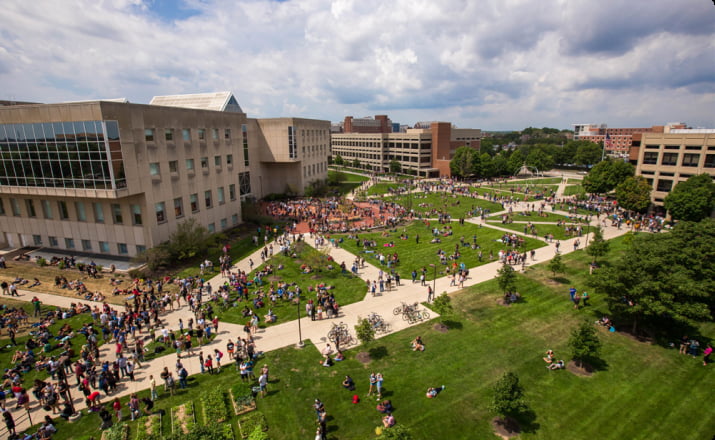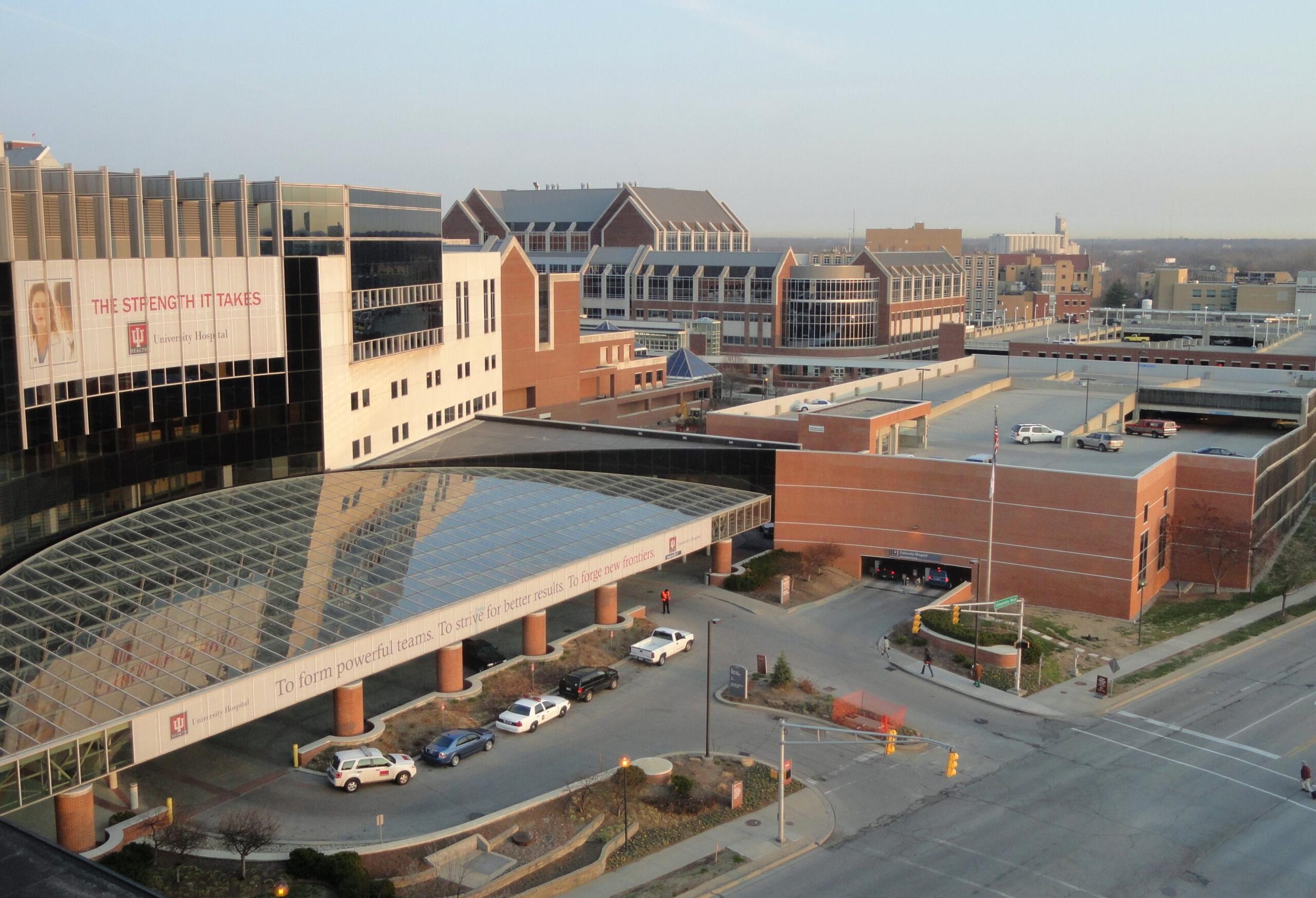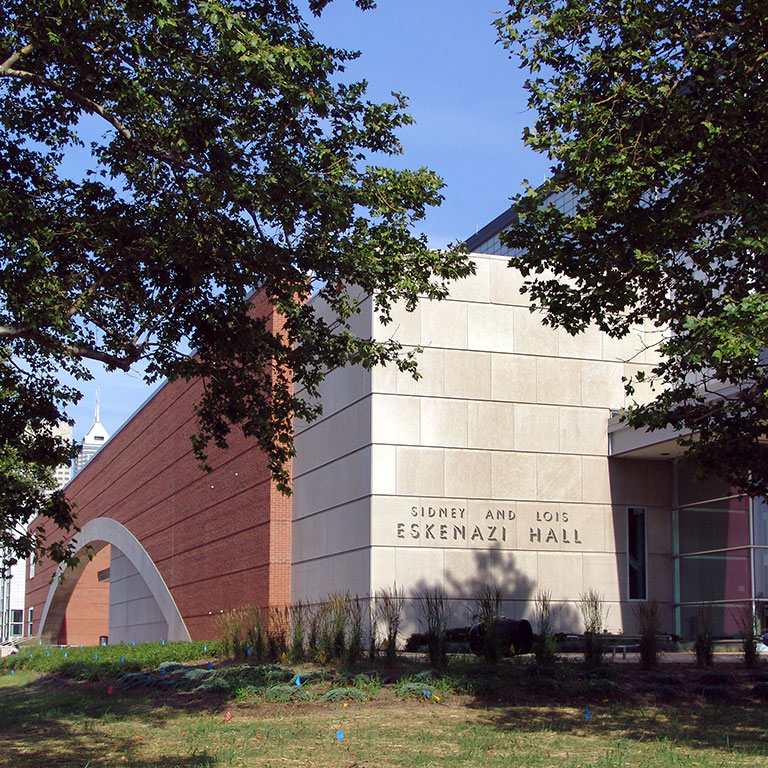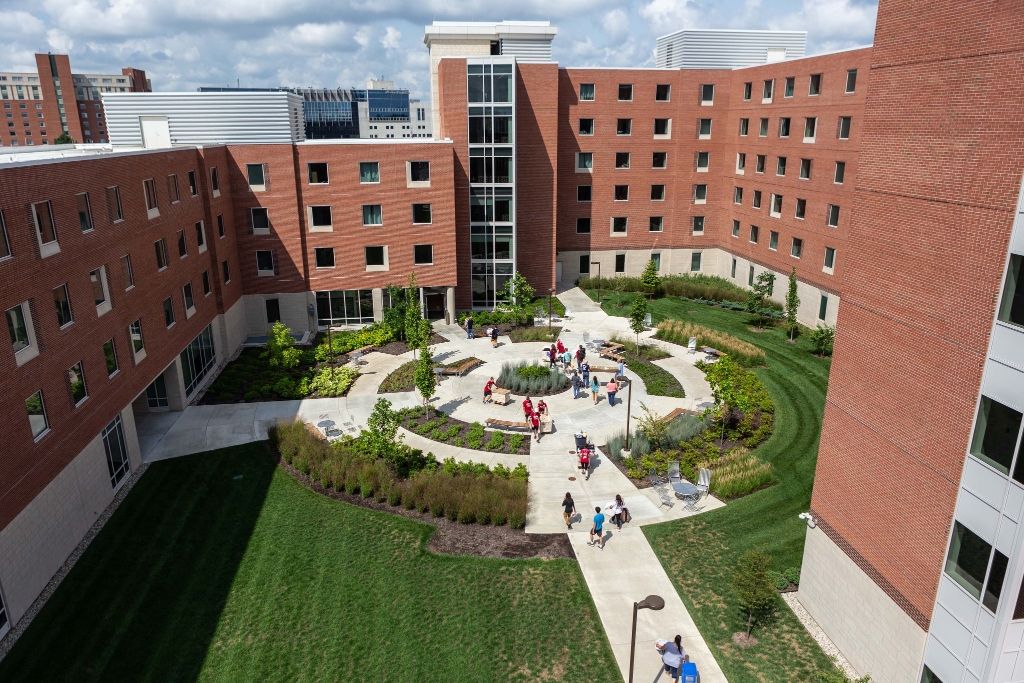Indiana University-Purdue University Indianapolis (IUPUI) is the premier urban research university in Indiana, offering more than 450 undergraduate, graduate, and professional programs on a downtown campus adjacent to the governmental, financial, and business center of the city and state.

Although the merger of state-university campuses in the capital city only occurred in 1969, IUPUI’s constituent parts reach back over 150 years and are intertwined with the cultural, educational, and institutional fabric of Indianapolis. The university is the product of generations of visionary citizens’ efforts to build public higher-education opportunities for city residents and to create a vibrant and engaged institution to serve the needs of the city, state, nation, and world.
Public higher education in Indianapolis dates to 1891, when an Indiana University professor ventured from Bloomington to the metropolis to give a series of public lectures on political economy. The lecture series was the result of agitation by civic leaders, prominent among them , who successfully called on Indiana University to provide educational opportunities to the city.
IU’s response occurred during the growing university-extension movement that spread across the United States. Professor Jeremiah W. Jenks first offered his lectures in churches located in downtown Indianapolis. In coming years, other scholars traveled from Bloomington once a week to lecture to growing numbers of participants, some who took the course for credit and others for the simple joy of learning. The university established an Extension Division in 1912 to offer lectures in a number of cities around the state, as well as Chicago, Illinois, and Louisville, Kentucky. In 1916 it created an Indianapolis Extension office to coordinate the growing number of courses given in the city.
The IU-Indianapolis Extension first occupied offices in a downtown bank building and offered classes at night in , then located at Pennsylvania and Michigan Streets, whose classrooms were offered free of charge. As the number of classes and participants grew, the university acquired and converted downtown office buildings to accommodate the numbers. In 1928 IU purchased and created classroom spaces in the Bobbs-Merrill building at 122 East Michigan Street, near the high-school building. In 1948, still growing numbers compelled university trustees to purchase the nearby Lumberman’s Mutual Insurance Company building at 518 North Delaware Street to add more classrooms, library space, and offices.

During this period of growth, IU seized opportunities to begin professional-degree programs. In 1908 the university commenced clinical medical training in Indianapolis with the creation of the (basic-science classwork began in Bloomington in 1903), taking over two private, proprietary medical schools: the Medical College of Indiana and the Central College of Physicians and Surgeons.
In the coming years, the university created an expansive medical center by collaborating with city philanthropists to build a series of hospitals adjacent to City Hospital just west of downtown: Robert W. Long Hospital in 1914, in 1924, William H. Coleman Hospital for Women in 1927, and University Hospital in 1970. The university created its Training School for Nurses in 1914 to staff Long Hospital. It was later renamed the . Programs to teach allied-health professions also developed to provide trained staff to care for hospital patients. To tap the wealth of medical and technical skill in the Medical Center, state government located its and the federal government erected a in close proximity.
Indiana University continued the practice of taking over struggling private institutions when in 1925 it “merged” with the Indiana Dental College to create the IU School of Dentistry. In 1933 the school moved to the Indiana University Medical Center campus. In 1941 IU merged with the , a physical-education school, which dated to 1866 and which had been located in Indianapolis since 1907.
In 1944 IU took over the cash-strapped private Indiana Law School and created an Indianapolis evening division of its Bloomington-based School of Law. The Indianapolis division won autonomy from the Bloomington law school in 1968 and is now called the IU Robert H. McKinney School of Law. Finally, in 1967 IU merged with the John Herron Art Institute, a private art school dating from 1902 with a distinguished roster of faculty and graduates, to create the .

Purdue University, a public land-grant university founded in 1869 and located in West Lafayette, Indiana, an institution focused on agriculture, technical, and engineering education, also yearned for an Indianapolis presence. In 1906-1907 it briefly had a toehold in the city when it won agreement from the two private medical schools to fold them under its wing. However, intense lobbying and political maneuvering by Indiana University leadership defeated Purdue’s plans by wresting the two schools away.
Purdue returned to Indianapolis in 1940, during efforts to gear up industrial production of war materiel by training factory workers. With U.S. entry into World War II in late 1941, Purdue established its Division of Technical Institutes to train workers in Indianapolis and other industrial cities in the state. In 1943 it acquired and converted the Marott building (formerly the Hoosier Athletic Club) at 902 North Meridian Street. As well, the university began to offer engineering courses in the city. After the war, Purdue established its Indianapolis Extension and continued in the Marott location until 1961, when it moved into purpose-built facilities on east 38th Street opposite the Indiana State Fairgrounds.
By the 1960s, both Indiana University and Purdue University had significant Indianapolis campuses and offered a wide range of educational programs to thousands of city residents. Starting in the 1950s, leaders of the two universities began to work with city planners to combine their physical facilities into what was envisioned as the “University Quarter,” the residential area immediately west of downtown and adjacent to the IU Medical Center. While IU and Purdue were to be adjacent to each other, their academic programs and institutional identities were to remain separate and distinct. Through the 1960s coordination with city mayors and urban planners advanced. But haggling over costs by the universities, especially Purdue, stalled efforts.
On December 14, 1968, a frustrated Indianapolis mayor gave a televised speech titled “A Great University for Greater Indianapolis.” He said Indianapolis needed a great research university to expand educational opportunities and fuel economic growth. But, he noted, squabbling by the state university leaders was postponing progress. He bluntly warned the two universities that politicians in the city were poised to force a law through the Indiana General Assembly to take away all Purdue and IU Indianapolis assets and create a new, independent, state university. He also noted that they planned to push passage of a state board of regents to oversee all state universities, a move that would curb the independent power of the two universities’ boards of trustees.
The leadership of Purdue and IU acted quickly to head off the city’s action. Within days of the mayor’s speech, the two university presidents reached a handshake deal whereby the Indianapolis operations of both universities would merge. IU would have management of the joint institution. The Boards of Trustees of both universities secretly ratified the merger deal, which took effect on January 24, 1969. While newspapers had gotten wind of the secret merger talks, the deal caught city residents and university faculty, staff, and students by surprise. Gradually, IU and Purdue lobbyists were able to sway state legislators to accept the merger; they also managed to fend off the board of regents plan, replacing it with the Indiana Commission for Higher Education, structured to be weaker and less threatening to the universities.
Since 1969, IUPUI has developed and expanded rapidly. Enrollments grew from 13,000 in 1969 to over 30,000 in 2021. Physical growth coalesced around the Medical Center campus, where for decades IU, using a front called the “Hoosier Realty Development Corporation,” had quietly purchased residential properties. The university then bulldozed the site or rented the property out until demolition at a later date. Photos of solitary houses surrounded by a sea of paved parking lots speak to the university’s methods.
Although the university used eminent domain proceedings only in rare instances, the result was the displacement of thousands of residents from the near-west side, which by the middle decades of the twentieth century was the home of a vibrant African American community. These actions sowed discontent and distrust of the institution by many African American residents of the neighborhood and the city. The demolition of a portion of the housing complex was especially troubling. From the time of the merger, the IUPUI Black Student Union, the most important student organization on the campus, voiced disapproval of the university’s methods and rallied on residents’ behalf. Recognizing the damage done, campus administrators have attempted to build trust and partnerships with city residents.
Administratively, Purdue faculty in the arts and social sciences merged with their IU counterparts and occupied new near-westside facilities. Slowly, over 20 years, Purdue programs at the 38th Street campus moved into new campus buildings. Finally, the seven city locations of IUPUI programs shrank to one when, in 2005, the Herron School of Art and Design moved from its location at 16th and Pennsylvania Streets to downtown. In 1974, in part to fend off continued efforts by city politicians to create an independent state university and nullify the IUPUI merger, Indiana University reorganized its eight-campus system and designated its Bloomington and IUPUI campus as “core campuses,” whereby the prestigious Kelley School of Business and the O’Neill School of Public and Environmental Affairs are inseparable and on both campuses.
Students who attended IUPUI in the 1970s and 1980s included many older and married men and women who held down full-time jobs in the city and attended classes in the evenings. Few students resided on campus. Consequently, campus student life was stunted. Student turnout to lectures, concerts, and intercollegiate sporting events was typically light.
Efforts to create campus community and spirit were often less than successful as students with little leisure time at their disposal commuted to campus for classes and then departed for home or employment. IUPUI administrators worked to increase campus housing units both to development campus life and to support improved academic performance. Gradually, student demographics became more “traditional” college-aged (i.e., 18-22 years old).

Given the fact that IUPUI was superimposed on a residential neighborhood, campus leaders made careful and conscious strides to engage neighborhood residents and citizens of the city. Among their efforts were the innovative Learn and Shop and Weekend College programs initiated by the School of Liberal Arts. Much like the extension movement of the late-19th century, the idea was to take higher education to the people when and where it was convenient to them.
IUPUI also collaborated with Indianapolis leaders to promote and host major sporting events as part of the city’s efforts to position itself as a sports destination. IUPUI’s tennis facility, track-and-field and soccer stadium, and the Natatorium swimming and diving complex have played host to scores of national and international competitions, including 1987 .
IUPUI intercollegiate sports programs developed slowly from inauspicious beginnings. The first IUPUI intercollegiate competition occurred in March 1971, when an IUPUI men’s intramural basketball team was entered in an intercollegiate tournament. In the following school year, a varsity men’s basketball team began to play against other collegiate teams. In the coming years, IUPUI established women’s and men’s programs and competed in the National Association of Intercollegiate Athletics (NAIA) conference, winning many trophies and advancing to national tournaments as the “Metros.” The women’s softball team was especially successful, competing in several consecutive NAIA national tournaments. In 1993, IUPUI joined the National Collegiate Athletics Association (NCAA) Division II; in 1997, IUPUI advanced to NCAA Division I status and became the Jaguars. IUPUI teams competed in the Mid-Continent Conference, later renamed the Summit League; IUPUI later moved to the .
The growth of IUPUI was viewed with suspicion by some Bloomington and West Lafayette faculty members and administrators, who long attempted to limit the number and focus of degrees offered by the urban university. Graduate degrees were initially restricted to medically related disciplines as part of the Medical Center. Nonetheless, owing to tenacious efforts by IUPUI faculty and leadership, many non-medical graduate programs, especially PhD programs, developed in IUPUI schools, the first being in the Psychology Department in the Purdue School of Science. As a result of the development of research programs, IUPUI researchers bring in hundreds of millions of research dollars annually from government and private funders, surpassing the West Lafayette and Bloomington campuses.
In 1997, IUPUI consolidated its leadership as the center for medical education, research, and clinical care in the state by merging its School of Medicine hospitals with in Indianapolis to create Clarian Health, later renamed . With hospitals and clinics all around Indiana, IU Health is one of the largest medical networks in the United States.
Since the 1969 merger, IUPUI has had a major economic and social impact on the city, as most of its over 200,000 graduates remain in Indianapolis and the state, and their presence has transformed and enriched the community in manifold ways. It is the third-largest institution of higher education in Indiana with 30,000 students and employs over 8,000 full-time faculty and staff with a $1.6 billion annual budget.
On August 12, 2022, the IU and Purdue board of trustees announced that IUPUI would split into two separate academic institutions. IU President Pam Whitten said the split would propel the Indianapolis campus “into becoming one of the preeminent urban research universities in the country.” Purdue President Mitch Daniels stated that Purdue would retain a presence and that “the state and its largest city require a world-class, high technology research presence of the quality that Purdue represents.” The realignment process was completed on July 7, 2024, with IU taking control over most of the existing campus, and adopting the name Indiana University Indianapolis.

Help improve this entry
Contribute information, offer corrections, suggest images.
You can also recommend new entries related to this topic.